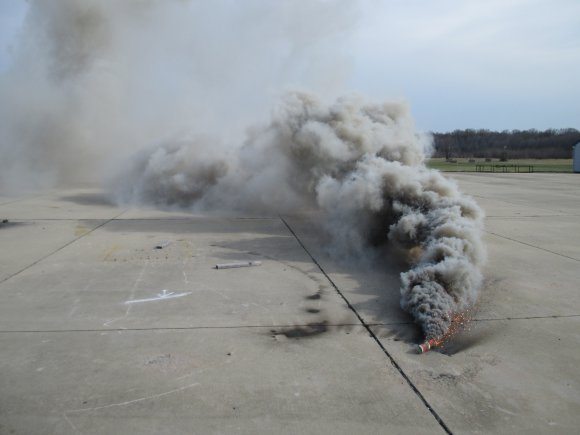The U.S. Army Edgewood Chemical Biological Center is researching and developing smoke screen compositions to keep pace with the changing face of conflict.
The U.S. Army Edgewood Chemical Biological Center, known as ECBC, is currently completing a multi-year effort to refine several smoke screen compositions that will allow troops to mask themselves from enemy fire.
A new formula will replace the World War II-era HC Screening Smoke Grenade. Offshoots have applications in short-range mortars, and long-range artillery shells.
Joseph A. Domanico, senior engineer for the Pyrotechnics and Explosives Branch, leads the smoke composition effort. Chemical engineers Giancarlo Diviacchi and Amee La Bonte and engineering technicians Mike Kauzlarich and Charles Young are also on the team.
“When people think of ECBC, they think of the great work in chem-bio defense equipment. Lesser known is the role ECBC plays in developing battlefield obscurants to protect the warfighter,” said Nino Bonavito, PEB chief.
Several potential smoke compositions are nearing the end of the decision cycle that will determine which composition goes into development to become the smoke composition of choice for the next century.
Before deciding, the Army will consider performance, manufacturing cost, toxicity, environmental impact and the availability of materials.
Four basic smoke compositions are being considered.
FIRST CANDIDATE
First is a zinc-free composition, HX, similar to the hexachloroethane composition, but one that does not produce a toxic, irritant smoke containing zinc chloride.
HC was the smoke of choice for many years, capable of pulling water from the atmosphere and doubling the amount of smoke produced. The HX composition has a similar action except that metals other than zinc produce smoke as dense as the HC, but without high amounts of acidity.
“The chemical reaction of the HX composition produces slightly less combustion products and has a higher efficiency, so the result is a similarly dense smoke cloud. This combination makes it the most exciting smoke composition in a long while,” Domanico said.
SECOND CANDIDATE
The second composition is hexachloroethane-free.
“The advantage of this composition is that none of the ingredients are water soluble, and that nearly eliminates the contamination of water supplies,” explained Domanico.
By encapsulating chlorine atoms in a plastic matrix, the potential for ground water contamination is nearly eliminated. The chlorine in the matrix is freed by the heat of combustion, allowing the smoke to pull water from the atmosphere and producing a dense smoke cloud. Because the rest of the plastic matrix is carbon, the smoke is filled with fine carbon particles giving a dark gray to black color.
This is unusual as the best smoke compositions are white, since white smoke reflects more light than darker smoke, resulting in a more effective smoke cloud.
THIRD CANDIDATE
The third candidate contains a solid solution of magnesium and aluminum, and produces a large quantity of metal oxides as its main smoke component. Basically, the smoke comes from the burning of the combination of metal powders.
This smoke is bright white and easily blends in a bowl with a binder, or in any other suitable mixing system.
Using a binder similar to “Super Glue,” the composition can be used in grenades, short range mortars and even in long-range artillery, allowing forces to be great distances from their targets. The “Super Glue” binder allows the smoke composition to be pressed into a hard, dense brick that can survive the flight from howitzer to target.
FOURTH CANDIDATE
The Lithium-Plus composition is the fourth smoke candidate. It is based on lithium combustion technology.
A chemical reaction uses a lithium salt to produce a superior smoke cloud, pulling large quantities of water from the atmosphere. Lithium salts are efficient, and result in a dense, bright white smoke cloud.
The compositions will be tested and evaluated in combat conditions, from cold to hot environments; in forest, desert and urban terrains; and whether or not friendly troops and civilians are in the combat zone.
ECBC continues to develop future smoke grenades, mortar cartridges, and artillery shells to offer the best options in future conflicts.
—–
The U.S. Army Edgewood Chemical Biological Center is part of the U.S. Army Research, Development and Engineering Command, known as REDCOM, which has the mission to develop technology and engineering solutions for America’s Soldiers.
RDECOM is a major subordinate command of the U.S. Army Materiel Command. AMC is the Army’s premier provider of materiel readiness — technology, acquisition support, materiel development, logistics power projection, and sustainment — to the total force, across the spectrum of joint military operations. If a Soldier shoots it, drives it, flies it, wears it, eats it or communicates with it, AMC provides it.











